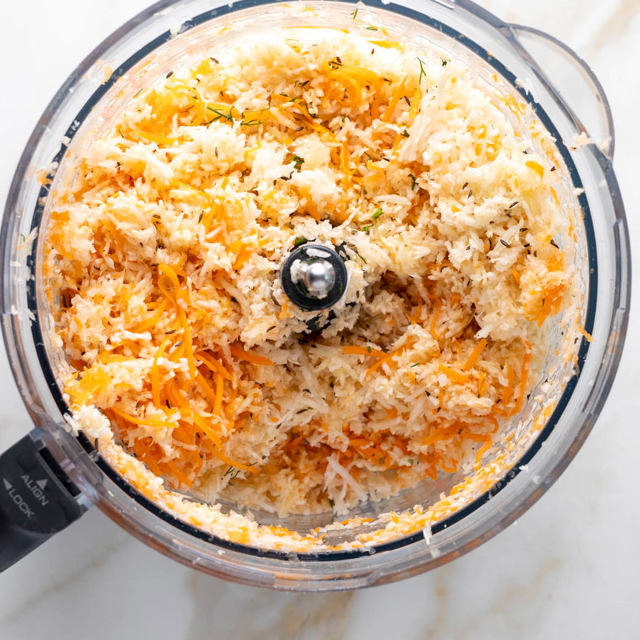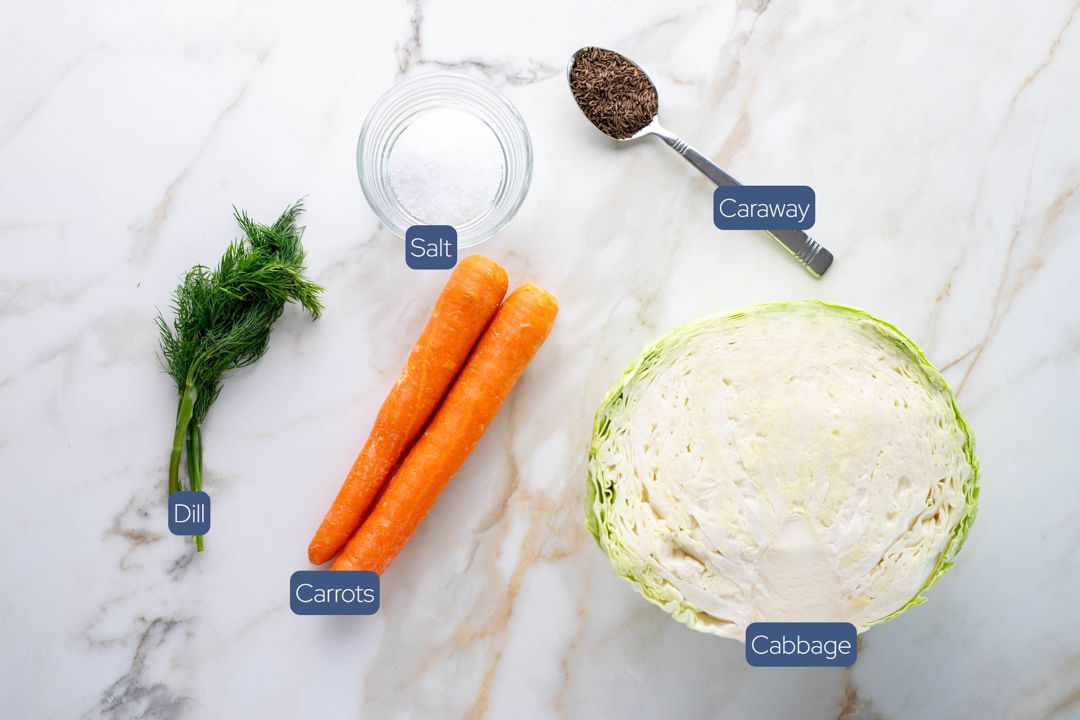I love sauerkraut. The probiotics from the fermentation, and the vitamin from the cabbage makes It incredibly good for you.
This recipe is for a sauerkraut made with carrot, dill and caraway seeds. The post itself doesn't go into the science of fermenting and making sauerkraut; if this recipe gets enough attention I'll write a post up on how to make sauerkraut.
Carrot, Dill and Caraway Sauerkraut Ingredients
- Carrot - carrot pairs very well with cabbage in sauerkraut as it shares a similar texture. It ferments well.
- Dill brings a fresh and herby taste to the sauerkraut which pairs well with the caraway.
- Caraway seeds is a common German ingredient and has a distinctive taste that pairs well with the other ingredients.
- Salt is a critical ingredient for sauerkraut. I recommend using 2% salt by weight of ingredients combined.

Carrot, Dill and Caraway Sauerkraut
| Prep | Total |
|---|---|
| 15 mins | 15 mins |
- 800g cabbage total weight outer leaves and core removed, see note 1
- 200g carrots (about 2 large), peeled
- 1 tbsp caraway seeds
- 8g dill, thin stalks and leaves only
- 20g salt 2% salt by the combined weight of the cabbage and carrots
- Sterilise all equipment with boiling water; this includes chopping boards, fermentation crock, knives, food processor (if using), etc. Weigh the bowl you'll be putting the vegetables in so that you know the starting weight.
- Prepare the carrot and cabbage - I like to use a food processor to grate, but you can use a box grater or even slice it very thinly with a knife. Alternatively, you can grate the cabbage and use a vegetable peeler to peel the carrot into ribbons. Add to a sterilised bowl ideally; if using a food processor you can keep it in the food processor bowl.
- Finely slice the dill - discard any thick stems before slicing. Add to the same bowl as the carrot and cabbage.
- Weigh vegetables - weigh the bowl with the vegetables now, and subtract the starting weight.
- Salt the vegetables - add 2% salt by weight of the vegetables to the vegetables. Add the caraway seeds.
- Massage the vegetables - thoroughly wash your hands and dry them. Massage and squeeze the vegetables. The goal is to break down the cell walls of the vegetables and encourage the release of water. Do this for about 5 minutes until the cabbage becomes more pliable and releases liquid. Stir the vegetables while you're doing this.
- Pack into container - pack the shredded vegetables into the fermentation container, pressing it down firmly to eliminate air pockets and ensure that the cabbage is submerged in its own juice.
- Weigh down the vegetables - place fermentation weights, or a bowl or plate over the vegetables and make sure the vegetables are submerged.
- Ferment - fermentation time can vary (see note). Check the sauerkraut after a few days and taste it. The process usually takes 1 to 4 weeks. The longer it ferments, the tangier it will become. If there are any signs of mould, discard immediately and do not consume.
- Store - fermented sauerkraut should be stored in a sterilised container in the fridge, with a lid. It will last a long time but not indefinitely; if there are any signs of mould growth discard it.
- Cabbage - remove any thick or damaged outer leaves, and remove the core of the cabbage. To remove the core of a cabbage, start by cutting it in half and identifying the tough core at the base. Use a knife to cut around the core in a V-shape or make a triangular cut to remove it from each half. Then, inspect the outer leaves for any damage or wilting. Peel away and discard any damaged outer leaves, ensuring to keep the fresh, crisp inner leaves for shredding and fermenting into sauerkraut.
- Fermentation times - see below for a guide. You should taste regularly to ensure the sauerkraut is fermented to your taste.
Warmer Temperatures (22-25°C / 72-77°F): Fermentation can be faster in warmer temperatures. Sauerkraut might be ready in about 1 to 2 weeks at these temperatures.
Room Temperature (18-22°C / 64-72°F): At typical room temperature, fermentation usually takes around 2 to 4 weeks. This range allows for a balanced fermentation process, producing tangy sauerkraut.
Cooler Temperatures (15-18°C / 59-64°F):
Fermentation can be slower in cooler environments. At these temperatures, sauerkraut might take 4 to 6 weeks or even longer to fully ferment and develop its desired flavour profile.
Cold Temperatures (Below 15°C / 59°F): In colder environments, fermentation significantly slows down. Sauerkraut may take several weeks to a few months to ferment adequately. It might develop a milder flavour profile compared to batches fermented at higher temperatures. You can try and offset this - and speed the process - by using a fermentation mat.















